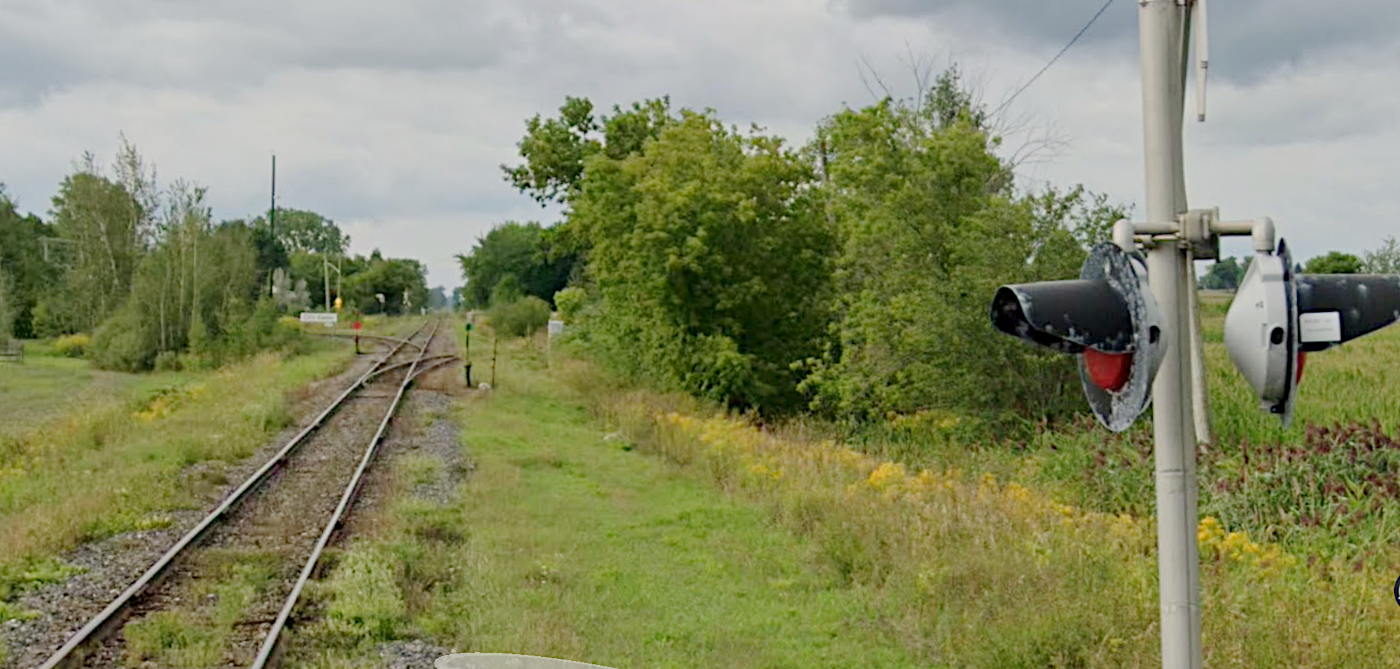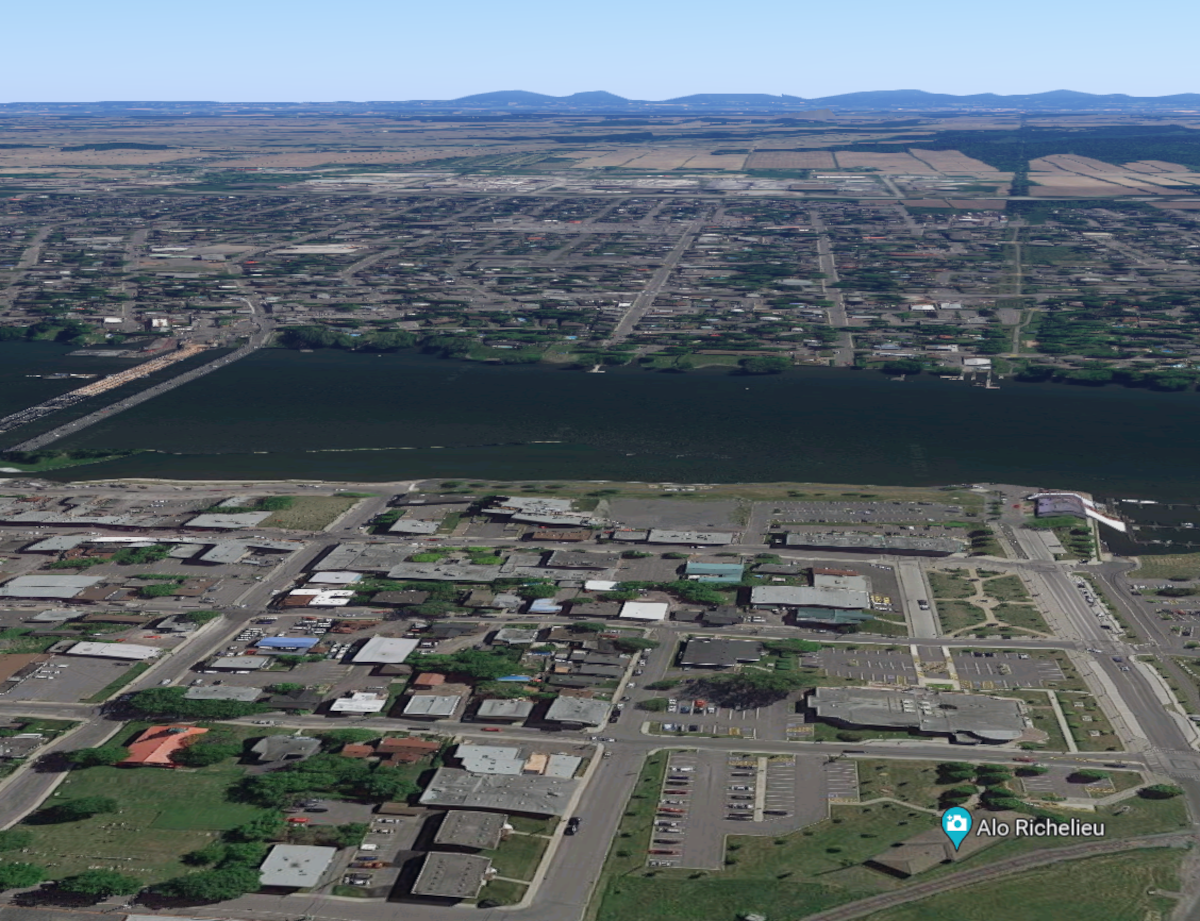When last we saw our intrepid fantrippers, they were near the Coteau station (above).
From Coteau the train will follow the Alexandria Sub, travelling timetable east
through Ayrness, Barrington and arriving at Cantic (employee timetable below).
The Canada Atlantic Railway routing is mentioned in the Itinerary which follows.
Cantic ... Canada Atlantic ... I wonder ...
The map above and itinerary below are repeated from Part 1.
We'll be following the route of trains 730 and 734 on the right side ...
I was curious to see which features of our route remained almost 60 years later. You'll see a number of Google map images of what remains.
Generally, we were travelling across a fertile plain which was often subdivided into the distinctive long, thin fields originating with New France's surveying and land-granting system.
* * *
Ayrness
Above and below: The runpast preparations at Ayrness. The man at the switchstand may be working with a battery-powered reel-to-reel recorder on the switch ties as he holds the microphone near the reversing train. A CRHA safety volunteer may be watching him with concern, as scalding water or steam may issue from the engine and he is within range. He'll certainly be cautioned to step back on the forward run. There was usually a CN Police officer on these trips as well.
Above: The site at Ayrness as it appears circa 2020. Unless otherwise indicated, all the Google views are oriented with North at the top.
Below: The 10-car train reversing after the runpast. A CRHA safety volunteer actuates the backup air whistle.
A uniformed CNR trainman is centred on the rear platform of the car as he uses the signal line to help re-spot the train in its original position. The sooner the railfans get back up the same steps of their own coaches, the sooner we can leave.
* * *
Barrington
Above: Non-gazeteered place names are often indicated on Google - as well as railway employee timetable 'stations'. The former roadbed of the west-to-east Alexandria Sub crosses the road at the 'ch' of 'Crutch'. The municipal location of Barrington appears to the south.
Under Barrington in the Alexandria Sub employee timetable footnotes above, you'll see a reference to a crossing of the Hemmingford Subdivision. The old, treed roadbed of the former north/south Hemmingford Sub can be seen better on the oblique view above.
The same crew of three fantrippers had already travelled on a diesel-powered wayfreight fantrip (i.e. a coach marshalled ahead of the caboose) to Hemmingford on June 6, 1964. The trip departed from Turcot Yard, and returned there after a very long day. The train only left Hemmingford around sunset - which is a little after 2030hr on that date. You can imagine the low priority given to the movement of a wayfreight waiting to travel over the Victoria Bridge and into the Montreal terminals in the evening.
Above and below: A couple of views at Barrington.
* * *
Cantic and its Location
Above: You can see the green cycling trail along the former Alexandria Sub from Barrington through to Cantic. At Cantic we will turn north-northwest and run in almost a straight line as we head for St Johns (St-Jean-sur-Richelieu) - seen across the river from Iberville.
Below: The dotted line marks the former Alexandria Sub. The train followed the green leg of the wye to the Rouses Point Sub (employee timetable below).
Below: An oblique view. The train travelled from the top-left corner to the top-right corner.
On the ground at Cantic:
Above: On the Rouses Point Sub looking timetable south toward the junction tracks at Cantic circa 2020. The excursion would have approached on the wye leg from the right and passed by the camera, travelling timetable north on the Rouses Point Sub for St Johns.
... Circa 2020, you can see that part of the leg of the wye still runs to the right toward the former Alexandria Sub roadbed which led back to Coteau. It is probably used as a back track.
We'll be following the route of trains 307 and 21 on the employee timetable below ...
* * *
Grande Ligne
Above: Grande Ligne - where a runpast occurred.
* * *
St Johns (St-Jean-sur-Richelieu)
Our excursion will be swinging by Rue Frontenac, around the curve at the station, and then across the diamond.
Why is that station always shown at that awkward angle to the curve?
The 1890 construction of the Grand Trunk Railway station (above, circa 2020) meshed with an already existing bridge of another railway across the Richelieu River. The first bridge here was begun in 1858 by the Stanstead, Shefford & Chambly Railroad, while the second bridge was built in 1864 and demolished after the line was abandoned in 1956.
Beginning at the station location at 'Alo Richelieu' you can imagine the location of the bridge by lining up the long green tangent, originally of the Stanstead, Shefford & Chambly, as it continues east on the far side of the river at Iberville.
* * *
Victoria Bridge circa 2020
The 1964 skyline of Montreal.
The new stock exchange building is being constructed and the reflection of the deputy photographer is seen as he is given permission to take an additional image in black and white as we cross the Lachine Canal.
We say good-bye to 6218 at Bridge.
The pushpin marks the general location of the steam cutoff point at Bridge Street. The time-honoured process would have involved cutting off the steam locomotive after coming in from the right (off the Victoria Bridge).
... After cutting off, the steam engine would continue a short distance toward Central Station, but then reverse along the west leg of the wye. (Before the late 1950s, the engine crew would go off duty at the Turcot roundhouse. In 1964 our engine is probably heading to the CNR's new Montreal freight yard.)
... An electric locomotive would back on to the passenger train's headend from a stub track near that pushpin, to lead the train along the tracks enclosed by Central Station. You can see today's Central Station/Place Bonaventure at the top, left corner of the image above. (Even in 2020, you can see shadows of unused catenary east of the wye ... so there would have been flexibility in where to stop the train and how to efficiently dispatch the light steam power.)
Were there other photos?: Given the average age of the kids in our excursion party, I don't think we attended the baggage car or the observation car. After the Barrington runpast, we may have stayed on the train for the duration of the trip.
























